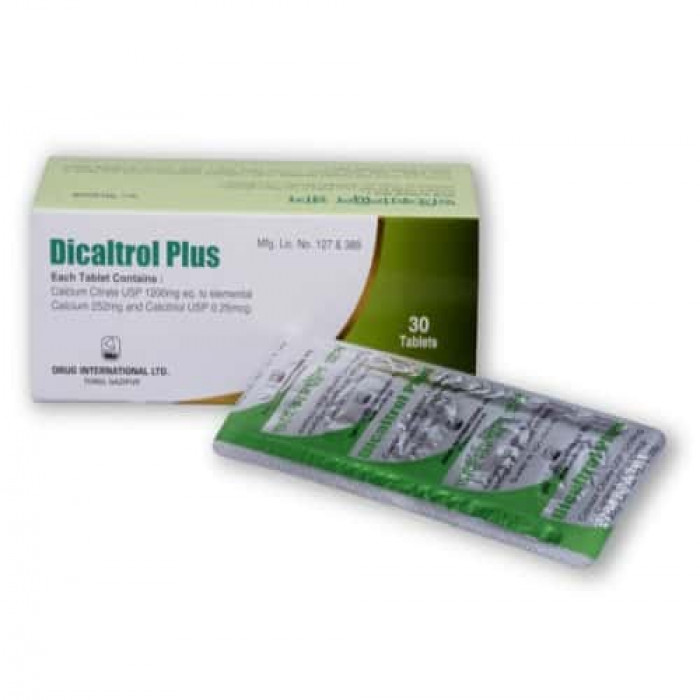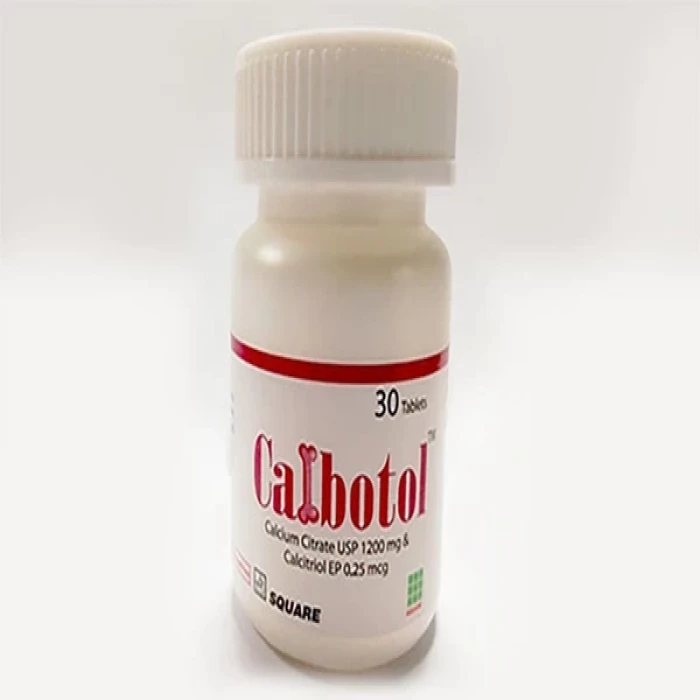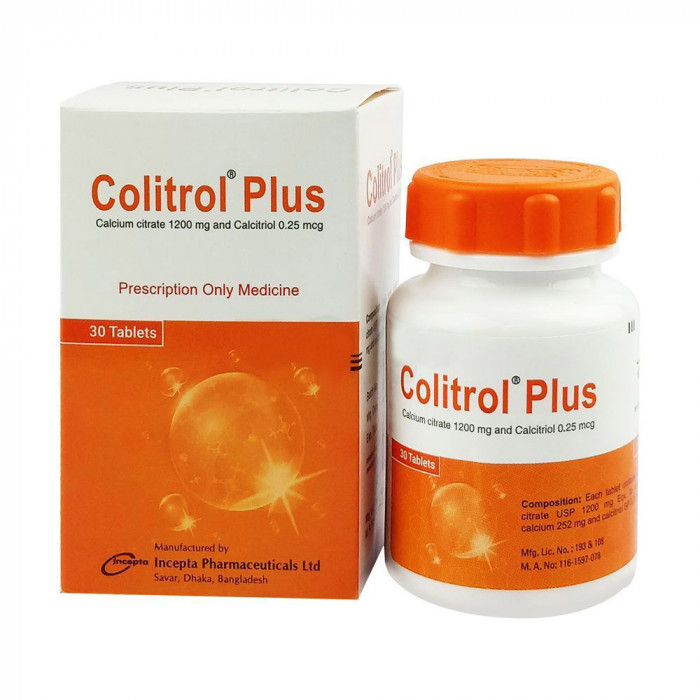

✔ 100% Authentic Product
👁️ Currently Viewing 1182
Dicaltrol Plus 1200mg+0.25mcg Tablet 1 Strip
- Dicaltrol Plus contains Calcium and Calcitriol to treat conditions like osteoporosis, hypoparathyroidism, hypocalcemia, osteomalacia, rickets, and renal osteodystrophy.
- It helps prevent and treat calcium deficiency and promotes calcium absorption in the intestines and kidney retention to raise serum calcium levels.
- The dosage and administration of Dicaltrol Plus depend on the specific condition being treated and may interact with other medications.
- The medication is contraindicated in cases of hypercalcemia, vitamin D toxicity, pregnancy, and lactation.
- Dicaltrol Plus can cause side effects such as polyuria, anorexia, irritability, and mild acidosis.
- It is crucial to take precautions and follow the doctor's instructions while taking Dicaltrol Plus.
- The medication should be stored below 30°C, away from light and moisture, and out of reach of children.
- Despite the risks, the medication's potential benefits may justify its use in pregnant women.

100% Genuine Products, Guaranteed
Safe & Secure Payments, Always
Fast, Secure & Efficient Delivery
Proper Packaging
 Cash on Delivery - All over Bangladesh
Cash on Delivery - All over Bangladesh Regular Delivery - 12-24 Hours, Dhaka City*
Regular Delivery - 12-24 Hours, Dhaka City* Regular Delivery - 24-48 Hours, All Over Bangladesh*
Regular Delivery - 24-48 Hours, All Over Bangladesh* ফ্রি ডেলিভারি! - ১৪৯৯ টাকা+ অর্ডারে ঢাকা
শহরে ।
ফ্রি ডেলিভারি! - ১৪৯৯ টাকা+ অর্ডারে ঢাকা
শহরে ।
✅ Description:
Dicaltrol Plus is a medication containing Calcium and Calcitriol used to treat conditions like osteoporosis, hypoparathyroidism, hypocalcemia, osteomalacia rickets, and renal osteodystrophy. It helps prevent and treat calcium deficiency, while promoting calcium absorption in the intestines and kidney retention to raise serum calcium levels. The dosage and administration of Dicaltrol Plus depend on the specific condition being treated, but it can interact with other medications. The medication is contraindicated in cases of hypercalcemia, vitamin D toxicity, pregnancy, and lactation. Dicaltrol Plus can cause side effects such as polyuria, anorexia, irritability, and mild acidosis. It is crucial to take precautions and follow the doctor's instructions while taking Dicaltrol Plus
✔️ Indications of Dicaltrol Plus
Conditions requiring a combination of Calcium and Calcitriol include Osteoporosis, Hypoparathyroidism, Hypocalcaemia, Osteomalacia Rickets, and Renal Osteodystrophy.
✔️ Pharmacology
Calcium salt can help prevent and treat calcium deficiency and negative calcium balance. It is also used as a supplement to aid in the prevention and treatment of osteoporosis.
Calcitriol raises serum calcium levels by promoting calcium absorption in the intestines and kidney retention. It also promotes phosphate resorption in the renal tubules, which reduces serum phosphatase, PTH, and bone resorption
✔️ Dosage & Administration of Dicaltrol Plus
- 0.25 mcg/day or every other day for hyperparathyroidism in renal failure. may gradually rise.
- 0.5-2 mcg once daily for hypoparathyroidism or pseudohypoparathyroidism.
- Rickets caused by a lack of vitamin D: 0.015–0.02 mcg/kg/day. 0.03-0.06 mcg/kg/day for maintenance. 2 mcg maximum daily.
- Dialysis patients with hyperparathyroidism receive 0.5–4 mcg three times per week. Maximum: 8 mcg three times per week.
- 0.5 mcg three times per week for hyperparathyroidism in renal failure, with possible increases of 0.25 to 0.5 mcg every 2-4 weeks. 3 times per week, 0.5–3 mcg for maintenance.
✔️ Interaction of Dicaltrol Plus
Thiazide diuretics or vitamin D can cause milk-alkali syndrome and hypercalcemia when taken together. Absorption is reduced as a result of corticosteroids. Reduced absorption is observed for tetracyclines, atenolol, iron, quinolones, alendronate, Na fluoride, zinc, and calcium-channel blockers. increases the heart's sensitivity to the effects of digitalis glycosides and may cause digitalis intoxication.
✔️ Contraindications
Hypercalcemia, vitamin D toxicity, pregnancy, and lactation
✔️ Side Effects
- Polyuria
- Polydipsia
- Anorexia
- Irritability
- Weight loss
- Nocturia
The symptoms mentioned above can be indicative of various medical conditions. In this case, the symptoms suggest a possible connection to an underlying health issue that requires medical attention.
Mild acidosis is a condition where the body's pH levels are slightly acidic. While it can be a result of several underlying health issues, it can lead to reversible azotemia, where the kidneys are unable to filter waste products from the blood effectively. This can lead to an increase in nitrogen levels in the bloodstream, which can be toxic.
Generalized vascular calcification and nephrocalcinosis are medical conditions where there is an abnormal accumulation of calcium in the blood vessels and kidneys, respectively. This can cause the hardening and narrowing of blood vessels, leading to reduced blood flow, and in severe cases, organ damage.
Conjunctivitis, also known as pink eye, can result from an infection or inflammation of the conjunctiva, the thin membrane that covers the white part of the eye. In calcific conjunctivitis, calcium deposits can form on the conjunctiva, leading to irritation and discomfort.
Pancreatitis is a condition where the pancreas becomes inflamed, causing abdominal pain, nausea, and vomiting. The condition can range from mild to severe, and in some cases, can cause long-term damage to the pancreas.
Photophobia is a medical condition where the eyes are overly sensitive to light, causing discomfort and pain in bright environments. This can be a symptom of an underlying condition or injury to the eyes.
Rhinorrhea is a condition where there is an excessive production of nasal mucus, often caused by allergies, infections, or exposure to irritants.
Pruritus is a medical term for itching, which can be caused by various underlying medical conditions or external factors.
Hyperthermia is a condition where the body temperature rises above normal levels, which can be a symptom of an underlying medical condition, such as an infection or heat stroke.
✔️ Pregnancy & Lactation
Pregnancy Classification: Although animal reproduction studies have shown that the drug has a negative effect on the fetus, and there are no adequate and well-controlled human studies, the drug's potential benefits may justify its use in pregnant women despite the risks.
✔️ Precautions & Warnings
Hypercalcemia is caused by an unknown cause. Pediatric doses must be tailored to the individual child and closely monitored by a physician. Coronary artery disease, renal impairment, and arteriosclerosis are all common in the elderly. Hypoparathyroidism.
✔️ Storage Conditions
Keep the temperature below 30°C and away from light and moisture. Keep out of children's reach.
⚠️Disclaimer:
At ePharma, we’re committed to providing accurate and accessible health information. However, all content is intended for informational purposes only and should not replace medical advice from a qualified physician. Please consult your healthcare provider for personalized guidance. We aim to support, not substitute, the doctor-patient relationship.








